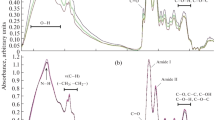Abstract
A quick and simple technique has been developed that is suitable to quantify the concentration of most types of biosurfactants in a typical growth medium using infrared spectroscopy. The area of the peak due to the carbonyl bond of the biosurfactant was measured and compared to the area of the nitrile peak in an internal standard (anthracenecarbonitrile). This ratio showed a linear trend with the concentration of biosurfactant in the medium for concentrations from 0.2 to 3.2 g biosurfactant l−1. The presence of hydrocarbons in the media and variations in the pH of the media did not interfere with the measurements.
Similar content being viewed by others
References
Banat IM (1995a) Characterization of biosurfactants and their use in pollution removal - state of the art. Acta Biotechnol. 15: 251–267.
Banat IM (1995b) Biosurfactants production and possible uses in microbial enhanced oil recovery and oil pollution remediation: a review. Bioresources Technol. 51: 1–12.
Bartha R (1986) Biotechnology of petroleum pollutant biodegradation. Microbiol. Ecol. 12: 155–172.
Chandrasekaran EV, BeMiller JN (1980) In: Methods in Carbohydrate Chemistry, Vol. III. New York: Academic Press, pp. 89.
Cooper DG, Zajic JE (1980) Surface-active compounds from microorganisms. Adv. Appl. Microbiol. 26: 229–253.
Cooper DG, MacDonald CR, Duff SJB, Kosaric N (1981) Enhanced production of surfactin from Bacillus subtilis by continuous product removal and metal cation additions. Appl. Environ. Microbiol. 42: 408–412.
Crosman JT (1998) Enhanced biosurfactant production using synchronous cultures of Corynebacterium alkanolyticum. MEng Thesis. Montreal, Canada: McGill University.
Desai JD, Banat IM (1997) Microbial production of surfactants and their commercial potential. Microbiol. Mol. Biol. Rev. 61: 47–64.
Dyer JR (1965) Applications of Absorption Spectroscopy of Organic Compounds. New Jersey: Prentice-Hall, Inc., pp. 34–36.
Klekner V, Kosaric N (1993) Biosurfactants for cosmetic. Surfactant Sci. Ser. 48: 373–389.
Lang S, Katsiwela E, Wagner F (1989) Antimicrobial effects of biosurfactants. Fett Wiss. Technol. 91: 363–366.
Lin S-C, Chen Y-C, Lin Y-M (1998) General approach for the development of high-performance liquid chromatography methods for biosurfactant analysis and purification. J Chromatogr. A 825: 149–159.
Matsufuji M, Nakata K, Yoshimoto A (1997) High Production of rhamnolipids by Pseudomonas aeruginosa growing on ethanol. Biotechnol. Lett. 19: 1213–1215.
Neu TR, Haertner T, Poralla K (1990) Surface active properties of viscosin - a peptidolipid antibiotic. Appl. Microbiol. Biotechnol. 32: 518–520.
Rosenberg E (1986) Microbial surfactants. CRC Crit. Rev. Biotechnol. 3: 109–132.
Schenk T, Schuphan I, Schmidt B (1995) High-performance liquid chromatographic determination of the rhamnolipids produced by Pseudomonas aeruginosa. J. Chromatogr. A 693: 7–13.
Shepherd R, Rockey J, Sutherland IW, Roller S (1995) Novel bioemulsifier from microorganisms for use in foods. J. Biotechnol. 40: 207–217.
Tabuchi T, Nakamura I, Kobayashi T (1977) Accumulation of the open-ring acid of spiculisporic acid by Penicillium spiculisporum in shake culture. J. Ferment. Technol. 55: 37–42.
Zajic JE, Seffens W (1984) Biosurfactants. CRC Crit. Rev. Biotechnol. 1: 81–107.
Zhou Q-H, Kosaric N (1995) Utilization of canola oil and lactose to produce biosurfactant with Candida bombicola. J. Am. Oil Chem. Soc. 72: 67–71.
Author information
Authors and Affiliations
Rights and permissions
About this article
Cite this article
Gartshore, J., Lim, Y. & Cooper, D. Quantitative analysis of biosurfactants using Fourier Transform Infrared (FT-IR) spectroscopy. Biotechnology Letters 22, 169–172 (2000). https://doi.org/10.1023/A:1005670031432
Issue Date:
DOI: https://doi.org/10.1023/A:1005670031432




